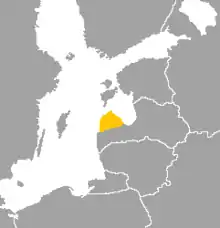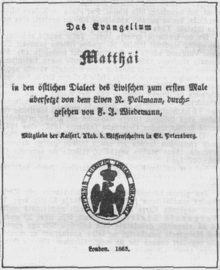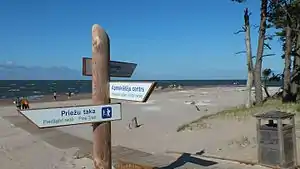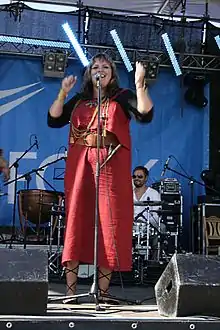Livonian language
Livonian (Livonian: līvõ kēļ or rāndakēļ) is a Finnic language. Although its last native speaker died in 2013,[1][6] it has been revived with about 40 reported speakers and 210 having reported some knowledge of the language. The native land of the Livonian people is the Livonian Coast of the Gulf of Livonia, located in the north of the Kurzeme peninsula in Latvia. Possibly unique among the Uralic languages, Livonian has been described as a pitch-accent language (see below).[7]
| Livonian | |
|---|---|
| līvõ kēļ | |
| Native to | Latvia |
| Region | Livonian Coast |
| Ethnicity | Livonians |
| Extinct | 2 June 2013, with the death of Grizelda Kristiņa[1][2] |
| Revival | ~40 L2 speakers at B1 and up ~210 at A1–A2[3] |
| Official status | |
Recognised minority language in | |
| Language codes | |
| ISO 639-3 | liv |
| Glottolog | livv1244 |
| ELP | Livonian[5] |
Distribution where the last Livonian speakers lived
Historic distribution of the Livonian language in Latvia | |
 | |
Some ethnic Livonians are learning or have learned Livonian in an attempt to revive it, but because ethnic Livonians are a small minority, opportunities to use Livonian are limited. The Estonian newspaper Eesti Päevaleht erroneously announced that Viktors Bertholds, who died on 28 February 2009, was the last native speaker who started the Latvian-language school as a monolingual.[8] Some other Livonians had argued, however, that there were some native speakers left,[9] including Viktors Bertholds' cousin, Grizelda Kristiņa. Kristiņa died in 2013.[1] An article published by the Foundation for Endangered Languages in 2007 stated that there were only 182 registered Livonians and a mere six native speakers. In a 2009 conference proceeding, it was mentioned that there could be "at best 10 living native" speakers of the language.[10]
The promotion of the Livonian language as a living language has been advanced mostly by the Livonian Cultural Centre (Līvõ Kultūr Sidām), an organisation of mostly young Livonians. Livonian as a lesser used language in Latvia – along with Latgalian – is represented by the Latvian Bureau of Lesser Used Languages (LatBLUL), formerly a national branch of the European Bureau of Lesser Used Languages (EBLUL).
The language is taught in universities in Latvia, Estonia and Finland, which constantly increases the pool of second-language speakers who do not constantly reside in Latvia.
History

In the 19th century, about 2,000 people still spoke Livonian; in 1852, the number of Livonians was 2,394.[11] Various historical events have led to the near total language death of Livonian:
- In the 13th century, speakers of Livonian numbered 30,000.[12]
- The German invasion: around the year 1200, the Livonian Brothers of the Sword and the Teutonic knights conquered Livonia, leading to contention of rule of the area between these orders and the Archbishopric of Riga.
- 1522: The introduction of the Protestant Reformation.
- 1557: The Russian invasion, also known as the Russo-Swedish War.
- 1558–1583: Livonian War. Russians, Swedes, Danes, Lithuanians and Poles fought over the area.
- 1721: The Treaty of Nystad. Northern Livonia became provinces of Tsarist Russia.
- 1918: The founding of Latvia; the Livonian language re-blossomed.
- World War II and Soviet Union: marginalisation of Livonian.
- Declared extinct on 6 June 2013.
- Revival of the Livonian language started after the last native speaker died.[13]
In the 13th century, the native Livonians inhabited the Estonian counties Alempois, Jogentagana Järva, Läänemaa, Mõhu, Nurmekund, Sakala, Ugandi, and Vaiga in the north, and by the Daugava in the south . The Livonian settlement of Curonia was also begun then.[14] In the 12th-13th centuries the Livonian lands were conquered by the Teutonic Order. The conquest led to a strong decrease in the number of speakers of the Livonian language, empty Livonian lands inhabited by the Latvians, which contributed to the replacement of the Livonian language in favor of Latvian.[15] It is estimated that at the time of the German colonization, there were 30,000 Livonians.[16] In the 19th century the number of speakers of the Couronian dialect is estimated as follows: 2,074 people in 1835, 2,324 people in 1852, 2,390 people in 1858, 2,929 people in 1888.[17] According to the Soviet Census of 1989, 226 people were Livonian, and almost half of them spoke Livonian.[18] According to estimates of the Liv Culture Center in 2010, only 40 people spoke Livonian in everyday life. In 2013, there were none who spoke Livonian in everyday life.[19]
Early literature
The first Livonian words were recorded in the Livonian Chronicle of Henry.[20] The first written sources about Livonian appeared in the 16th century. The collection of Livonian poems "Mariners sacred songs and prayers" (Latvian: Jūrnieku svētās dziesmas un lūgšanas) was translated to Latvian by Jānis Prints and his son Jānis Jr. and was published in 1845.[21][22] The first book in Livonian was the Gospel of Matthew, published in 1863 in London in both the eastern and western Courland dialects.[23] It was translated into eastern Couronian by Nick Pollmann and into western Couronian by Jānis Prints and Peteris. The plan with the book was to establish a standard orthography by F. Wiedemann, which consisted of 36 letters with many diacritics. The total circulation was 250 copies.[24] The Livonians received only one copy of each dialect.[25] The second book in Livonian was the same Gospel of Matthew, published in 1880 in St. Petersburg, with an orthography based on Latvian and German.[24][26]
In the interwar period, there were several dozen books published in Livonian, mainly with the help of Finnish and Estonian organizations.[23] In 1930, the first newspaper in Livonian, "Līvli", was published. In 1942, a translation of the New Testament was published in Helsinki. It was translated by Kōrli Stalte, with help from the Finnish linguist Lauri Kettunen.[27] After the war, books in Livonian were no longer published,[28] as Latvia was occupied by the Soviet Union.
After Latvia regained its independence, the newsletter "Õvâ" was published in Livonian in 1994, dedicated to the Livonian culture, art, and figures of the national movement, and in 1998 with the support of the "Open Society," the first collection of poetry in Livonian, "Ma akūb sīnda vizzõ, tūrska!", was published and presented in Finland and Estonia. It combines the works of famous Livonian poets.[29][30] To date, the only Livonian media outlet is trilingual (English-Latvian-Livonian) livones.lv (livones.net) operated by the Liv Culture Center.[30][31]
Two sites were included in the Atlas Linguarum Europae to study Livonian: Miķeļtornis and Mazirbe.[32]
Speakers of Livonian in the twenty-first century


Viktors Bertholds (July 10, 1921 – February 28, 2009),[33][34] one of the last Livonian speakers of the generation who learned Livonian as a first language in a Livonian-speaking family and community, died on February 28, 2009. Though it was reported that he was the last native speaker of the language, Livonians themselves claimed that there were more native speakers still alive, albeit very few.[35]
As reported in the Estonian newspaper Eesti Päevaleht,[36] Viktors Bertholds was born in 1921 and probably belonged to the last generation of children who started their (Latvian-medium) primary school as Livonian monolinguals; only a few years later it was noted that Livonian parents had begun to speak Latvian with their children. During World War II, Bertholds, unlike most Livonian men, managed to avoid being mobilized in the armies of either occupation force by hiding in the woods. After the war, Bertholds worked in various professions and shared his knowledge of Livonian language with many field linguists; in the 1990s, he also taught Livonian in children's summer camps.
Bertholds' Livonian-speaking brother and wife died in the 1990s. In the early 2000s, many other prominent "last Livonians" also died, such as Poulin Klavin (1918–2001), keeper of many Livonian traditions and the last Livonian to reside permanently on the Courland coast, and Edgar Vaalgamaa (1912–2003), clergyman in Finland, translator of the New Testament and author of a book on the history and culture of the Livonians.[37][38]
Supposedly the last native speaker of Livonian was Grizelda Kristiņa, née Bertholde (1910–2013, a cousin of Viktors Bertholds), who lived in Canada from 1949.[39] According to Valts Ernštreits, she spoke Livonian as well "as if she had stepped out of her home farm in a Livonian coastal village just yesterday".[40] and qualified as the last living native speaker of the Livonian language of her generation. She died on June 2, 2013.[41]
The survival of the Livonian language now depends on young Livonians who learned Livonian in their childhood from grandparents or great-grandparents of the pre-war generations. There are not many of them, though there are a few hundred ethnic Livonians in Latvia now who are interested in their Livonian roots. Some young Livonians not only sing folk-songs in Livonian but even strive to use Livonian actively in everyday communication. One such younger generation Livonian speaker is Julgī Stalte, who performs with the Livonian-Estonian world music group Tuļļi Lum.[42]
Phonology
Livonian, like Estonian, has lost vowel harmony, but unlike Estonian, it has also lost consonant gradation.[43][44]
Vowels
Livonian has 8 vowels (the two unrounded front vowels, marked with the dagger [†], were present in earlier generations but merged with other vowels in later generations; these were present dialectally as late as 1997):
| Front | Front Rounded |
Central | Back Unrounded1 |
Back | |
|---|---|---|---|---|---|
| Close | i /i/ | († y /y/) | õ /ɨ/ | [ɯ] | u /u/ |
| Mid | e /ɛ~e/2 | († ö /œ/) | [ə]3 | ȯ /ɤ/ | o /o/ |
| Open | ä /æ/ | a /ɑ/ |
- Back versus central articulation is not significant for non-front unrounded vowels, so õ and ȯ can also be marked as central ([ɨ~ɯ] and [ɤ~ɘ], respectively).
- e may either be pronounced as [ɛ] or [e̞].
- Unstressed õ /ɨ/ is realized as [ə].
All vowels can be long or short. Short vowels are written as indicated in the table; long vowels are written with an additional macron ("ˉ") over the letter, so, for example, [æː] = ǟ. The Livonian vowel system is notable for having a stød similar to Danish. As in other languages with this feature, it is thought to be a vestige of an earlier pitch accent.
Livonian has also a large number of diphthongs, as well as a number of triphthongs. These can also occur short or long.
The two opening diphthongs /ie/ and /uo/ vary in their stress placement depending on length: short ie, uo are realized as rising [i̯e], [u̯o], while long īe, ūo are realized as falling [iˑe̯], [uˑo̯]. The same applies to the triphthongs uoi : ūoi.[45]
Consonants
Livonian has 23 consonants:
| Labial | Dental | Palatal | Velar | Glottal | ||
|---|---|---|---|---|---|---|
| Nasal | m /m/ | n /n/ | ņ /ɲ/ | [ŋ]1 | ||
| Plosive | voiceless | p /p/ | t /t̪/ | ț /c/ | k /k/ | |
| voiced | b /b/ | d /d̪/ | ḑ /ɟ/ | g /ɡ/ | ||
| Fricative | voiceless | f /f/ | s /s/ | š /ʃ/ | h /h/ | |
| voiced | v /v/ | z /z/ | ž /ʒ/ | |||
| Trill | r /r/ | ŗ /rʲ/ | ||||
| Approximant | central | j /j/ | ||||
| lateral | l /l/ | ļ /ʎ/ | ||||
/n/ becomes [ŋ] preceding /k/ or /ɡ/.
Alphabet
The Livonian alphabet is a hybrid which mixes Latvian and Estonian orthography.
| Majuscule forms (also called uppercase or capital letters) | ||||||||||||||||||||||||||||||||||||||||||
|---|---|---|---|---|---|---|---|---|---|---|---|---|---|---|---|---|---|---|---|---|---|---|---|---|---|---|---|---|---|---|---|---|---|---|---|---|---|---|---|---|---|---|
| A | Ā | Ä | Ǟ | B | D | Ḑ | E | Ē | F | G | H | I | Ī | J | K | L | Ļ | M | N | Ņ | O | Ō | Ȯ | Ȱ | Ö* | Ȫ* | Õ | Ȭ | P | R | Ŗ | S | Š | T | Ţ | U | Ū | V | Y* | Ȳ* | Z | Ž |
| Minuscule forms (also called lowercase or small letters) | ||||||||||||||||||||||||||||||||||||||||||
| a | ā | ä | ǟ | b | d | ḑ | e | ē | f | g | h | i | ī | j | k | l | ļ | m | n | ņ | o | ō | ȯ | ȱ | ö* | ȫ* | õ | ȭ | p | r | ŗ | s | š | t | ţ | u | ū | v | y* | ȳ* | z | ž |
| * denotes letters were used for phonemes that were unrounded in later generations; these were used as late as 1997. | ||||||||||||||||||||||||||||||||||||||||||
Grammar
Language contacts with Latvians and Estonians
Livonian has for centuries been thoroughly influenced by Latvian in terms of grammar, phonology and word derivation etc. The dative case in Livonian, for example, is very unusual for a Finnic language.[46] There are about 2,000 Latvian and 200 German loanwords in Livonian and most of the German words were adopted through Latvian.[47] Latvian, however, was influenced by Livonian as well. Its regular syllable stress, which is based on Livonian, is very unusual in a Baltic language. Especially as of the end of the nineteenth century there was a great deal of contact with Estonians, namely between (Kurzeme) Livonian fishers or mariners and the Estonians from Saaremaa or other islands. Many inhabitants of the islands of Western Estonia worked in the summer in Kurzeme Livonian villages. As a result, a knowledge of Estonian spread among those Livonians and words of Estonian origin also came into Livonian.[48] There are about 800 Estonian loanwords in Livonian, most of which were borrowed from the Saaremaa dialect.[49]
Common phrases
- Hello! – Tēriņtš!
- Enjoy your meal! – Jõvvõ sīemnaigõ!
- Good morning! – Jõvā ūomõg! / Jõvvõ ūomõgt!
- Good day! – Jõvā pǟva! / Jõvvõ päuvõ!
- Good night! – Jõvvõ īedõ!
- Thank you! – Tienū!
- Happy new year! – Vȯndzist Ūdāigastõ!
- die – kȭlmä
- one – ikš
- two – kakš
- three – kuolm
- four – nēļa
- five – vīž
- six – kūž
- seven – seis
- eight – kōdõks
- nine – īdõks
- ten – kim
See also
- Min izāmō – the national anthem of the Livonians
- Tuļļi Lum – Livonian-Estonian world music group
References
- David Charter (2013-06-05). "Death of a language: last ever speaker of Livonian passes away aged 103". The Times. Retrieved 2013-12-01.
- "Viimane emakeelne liivlane lahkus jäädavalt" Postimees, June 14, 2013 (in Estonian)
- "LĪBIEŠU VALODAS SITUĀCIJA". Archived from the original on 2014-02-02. Retrieved 2012-01-19.
- Keeping Livonian - Latvia's Lesser Known Language - Alive, 17.06.2007 at dw.de
- Endangered Languages Project data for Livonian.
- "Obituary: Last Native Speaker of the Livonian Language Died Age 103". GeoCurrents. Archived from the original on October 26, 2013. Retrieved 2013-12-01.
- "Sketch of Livonian Sounds and Grammar". Virtual Livonia. Retrieved 2020-03-22.
- (in Estonian) Eesti Päevaleht Archived 2011-07-20 at the Wayback Machine "Suri viimane vanema põlve emakeelne liivlane" ("The last native speaker of Livonian from the older generation has died"), March 4, 2009.
- "Latvia's tiny Livonian minority struggles to keep its language alive | Baltic States news & analytics". The Baltic Course. 2012-10-17. Retrieved 2013-12-01.
- Balodis, Pauls (August 2009). "Personal Names of Livonian Origin in Latvia: Past and Present" (PDF). In Wolfgang Ahrens; Sheila Embleton; André Lapierre (eds.). Proceedings of the 23rd International Congress of Onomastic Sciences. 23rd International Congress of Onomastic Sciences. Toronto, Canada: York University. pp. 105–116. ISBN 978-1-55014-521-2. Retrieved 23 April 2011.
- (Ariste 1981, p. 78)
- (Schätzung Vääri 1966)
- https://deepbaltic.com/2019/07/15/twenty-speakers-but-three-poets-writing-in-livonian/. Missing or empty
|title=(help) - (Moseley 2002, p. 5)
- Ariste, P.A. (1958). "Известия АН Латвийской ССР: Ливы и ливский язык" (11). p. 32.
- de Sivers, F. (2001). Parlons live: une langue de la Baltique. Paris; Budapest; Torino: L'Harmattan. p. 16. ISBN 2-7475-1337-8.
- (Moseley 2002, p. 6)
- Viitso, Т.-Р. (1993). Ливский язык: Языки мира. Уральские языки. Moscow: Наука. pp. 76–77. ISBN 5-02-011069-8.
- "Lībiešu valoda" (in Latvian). livones.net. 2011-11-11. Archived from the original on 2014-12-22. Retrieved 2014-12-22.
- (Schätzung Vääri 1966, p. 139)
- Juhrneeku svehtas dseesmas un luhgschanas, sadomahtas no zitkahrtiga Pises basnizas ķestera Jahņa Prinz, un viņņa vezzaka dehla Jahņa. Jelgavā pee Jahņa Wridriķķa Steffenhagen un dehla. 1845
- Latvian encyclopedia . Volume 4. Riga: Valery Belokon's Publishing. 2007 p. 832-833 ISBN 978-9984-9482-4-9.
- (Laanest 1975, p. 21)
- (Moseley 2002, p. 8)
- (Uralica, p. 14)
- (Uralica, p. 15)
- (Moseley 2002, p. 11)
- (Schätzung Vääri 1966, p. 138)
- "Lībiešu literatūra" (in Latvian). livones.net. 2011-12-12. Archived from the original on 2014-12-27. Retrieved 2014-12-27.
Tā ir 1998. gadā Rīgā iznākusī lībiešu dzejas antoloģija „Es viltīgāks par tevi, menca”, kurā apkopoti visu zināmāko lībiešu dzejnieku – pavisam 24 – darbi.
- "Kultūras centrā 'Noass' notiks Lībiešu valodas dienas svinēšana" (in Latvian). www.DELFI.lv. 2007-05-17. Retrieved 2014-12-27.
- "Archived copy" Латыши без ливов — как суп без соли: настоящий лив живет в… Канаде (in Russian). D-PiLS.LV. Информационно-развлекательный портал Даугавпилса. 2011-03-09. Archived from the original on 2014-12-27. Retrieved 2014-12-27.CS1 maint: archived copy as title (link)
- Eder, Birgit (2003). Ausgewählte Verwandtschaftsbezeichnungen in den Sprachen Europas. Frankfurt am Main: Peter Lang. p. 307. ISBN 3631528736.
- Picture of V. Bertholds Archived 2012-02-22 at the Wayback Machine
- Laakso, Johanna. "The last Livonian is dead". Tangyra. Retrieved 2009-06-09.
- "Latvia's tiny Livonian minority struggles to keep its language alive", Baltic Course, 6 June 2013 (retrieved 6 June 2013)
- (in Estonian) Eesti Päevaleht Archived 2011-07-20 at the Wayback Machine "Suri viimane vanema põlve emakeelne liivlane″ ("The last native speaker of Livonian from the older generation has died"), March 4, 2009.
- Valkoisen hiekan kansa, Jyväskylä 2001
- Edgar Vaalgamaa - Muistokirjoitus - Muistot, hs.fi, Retrieved 2 March 2015.
- Tapio Mäkeläinen (2010-03-19). "Maailma viimane emakeelne liivlane sai 100-aastaseks". FennoUgria. Retrieved 2011-04-01.
- Raimu Hanson. Teadusdoktor käib mööda liivi radu. Postimees, 09.12.2011. (Accessed December 9, 2011.)
- David Charter (2013-06-05). "Death of a language: last ever speaker of Livonian passes away aged 103". The Times. Retrieved 2013-12-01.
- Jakobs, Hubert (July 10, 2000). "Defender of a Small Nation". Central Europe Review. Archived from the original on March 3, 2016. Retrieved February 2, 2007.
- (Laanest 1975, p. 18)
- Tsypanov, Е. А. (2008). Сравнительный обзор финно-угорских языков. Syktyvkar: Kola. p. 191. External link in
|title=(help) - Posti, Lauri (1973). "Alustava ehdotus liivin yksinkertaistetuksi transkriptioksi". FU-transkription yksinkertaistaminen. Castrenianumin toimitteita. 7. ISBN 951-45-0282-5.
- Gyula Décsy: Einführung in die finnisch-ugrische Sprachwissenschaft, page 81. Wiesbaden 1965
- Gyula Décsy: Einführung in die finnisch-ugrische Sprachwissenschaft, page 82. Wiesbaden 1965
- (Ariste 1981, p. 79)
- Gyula Décsy: Einführung in die finnisch-ugrische Sprachwissenschaft, page 83. Wiesbaden 1965
- Moseley, Christopher (2002) Livonian, München: LINCOM EUROPA (English)
- Fanny de Sivers. 2001. Parlons live – Une langue de la Baltique. Paris: L'Harmattan. ISBN 2-7475-1337-8. (in French)
- Paul Ariste 1981. Keelekontaktid. Tallinn: Valgus. [pt. 2.6. Kolme läänemere keele hääbumine lk. 76 - 82] (in Estonian)
- Lauri Kettunen. 1938. Livisches Wörterbuch : mit grammatischer Einleitung. Helsinki: Finno-Ugrian Society. (in German)
- Tooke, William (1799). View of the Russian Empire During the Reign of Catharine the Second, and to the Close of the Present Century. London: T. N. Longman, O. Rees, and J. Debrett. pp. 523–527.
- Vääri, E.E. (1966). Ливский язык: Языки народов СССР: Финно-угорские и самодийские языки. Moscow: Nauka. p. 139.
- Laanest, A. (1975). Basics Finno-Ugric Linguistics (Finnic, Sami and Mordovia languages). Moscow: Science.
- Ernštreits, V. (2007). "Livonian Orthography" (PDF). Linguistica Uralica. 43 (1). ISSN 0868-4731.
External links
 Media related to Livonian language at Wikimedia Commons
Media related to Livonian language at Wikimedia Commons
| Wikisource has original text related to this article: |
| Livonian language test of Wikipedia at Wikimedia Incubator |
- Livones.lv
- Virtual Livonia
- Latvian–Livonian–English Phrase Book
- Livonian language resources at Giellatekno
- Livonian - Latvian/Estonian/Finnish dictionary (robust finite-state, open-source)